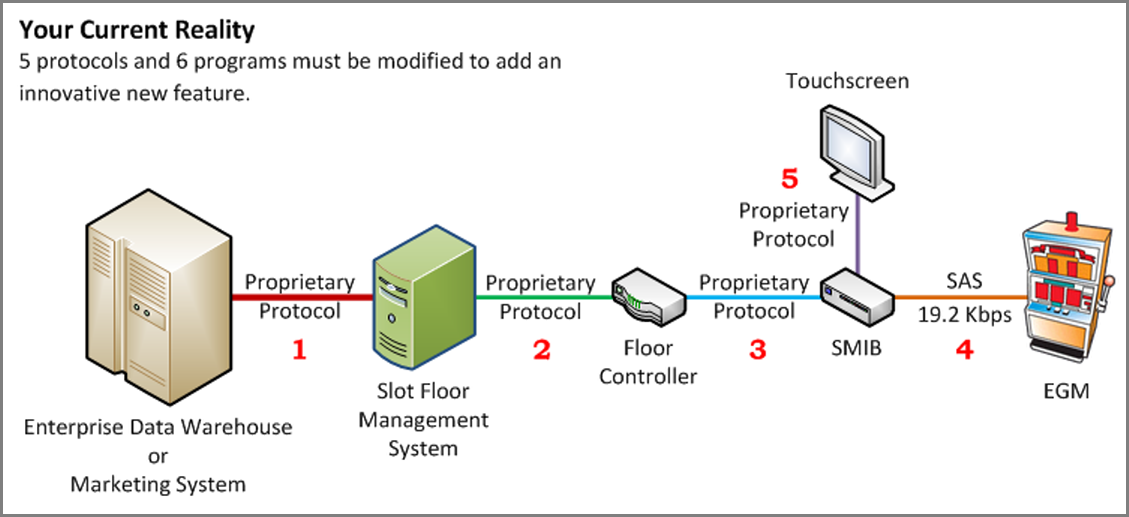The proprietary slot floor: pros and cons
Do we move to an open-standard, high-speed network or stay with the current proprietary network we’ve got?
That is the question being discussed by casino operators worldwide. To facilitate the discussion, it may be useful to step back and take a look at some of the pros and cons of the typical slot floor network on most gaming floors today. As a point of reference, most casino slot floor networks currently look something like this:
The Pros
Comfortable
Like your favorite sweatshirt, your current network may have a few holes, but you know it well and it still serves its intended purpose.
Well-Tested
Most existing slot floors have been around for nearly 20 years, so many of the problems have been found and (hopefully) corrected.
Avoids the Awkwardness and Frustration of Dating
When you commit to a vendor that uses a proprietary slot floor system, for the most part, you only have to focus on that one relationship. Whether it’s calling support, getting training for your team or inquiring about new features, having a single point of contact (and responsibility) can be reassuring. Of course, marriage can have its own share of awkwardness and frustration, but I’ll leave that for another time.
Less Regulation
Since all traffic on a proprietary slot floor goes through a Slot Machine Interface Board (SMIB), new functionality that does not affect the game does not require regulatory approval. (Well, it didn’t until Ticket In/Ticket Out was added to slot floor systems. After that, the system was considered a gaming device, so any change is now highly regulated.)
Less Expensive
By far, staying with your existing slot floor network is the less expensive option in terms of up-front costs because you already have the system and network in place. Your costs for an existing proprietary network mainly involve new features, minor upgrades and maybe a bit of training.
The Cons
Overly Complicated
If the new feature is going to be initiated by your enterprise data warehouse or marketing system, and includes an interaction with the player and an update to the credit meter on the EGM, there are potentially five different protocols that need to be modified (some of which may not even be controlled by your system vendor). With so many moving parts, the possibility of issues creeping into a feature increases for each protocol on the network.
Inefficient
There are as many as six different program environments that must be modified, tested, approved and deployed to your gaming floor in order for a feature to be available to your players. No wonder the typical development cycle is 18 months or more! This lengthy and complicated development cycle presents significant challenges to the rapid development and deployment of new features.
Slow, Limited Communications
The final connection to the EGM uses a slow, polled serial communication link running a protocol called SAS (created 20+ years ago). This SAS link works pretty well over a local connection with the SMIB, but it can’t be used to move large amounts of data to or from the EGM, nor could it ever be used to talk to multiple hosts. Most player interactions are done using player peripherals hung off a third-party SMIB that is supplied by your slot system vendor because player interactions can’t happen across the SAS communication link.
Discourages Innovation
All of the protocols in use (other than SAS) are developed by the system vendor with an eye towards securing their floor network environment (an incredibly important concern when processing vouchers, transferring money and doing other important business functions). However, most don’t employ off-the-shelf security mechanisms (like TLS or SSL) as those types of industry standard solutions are not really available for custom-developed communication protocols. Plus, due to the proprietary nature of the interfaces, any innovation must come from or be sanctioned by the slot system vendor. While slot system vendors are very capable, network lock-in as well as proprietary/non-standard protocols discourage standard Internet technologies and new ideas from moving easily to the slot floor.
In a nutshell, there is certainly a case to be made for proprietary networks. Each casino will have its own set of considerations when deciding how to move its slot floor into the future.
What do you see as the pros and cons of proprietary slot floor networks?




eastlandgrl
interesting, thanks
badmash
I just signed up to your blogs rss feed. Will you post more on this subject?
sam
Absolutely! Be sure to check out our Networked Gaming Resources page — it has links to networked gaming articles and original content that explore G2S as well as networked gaming.
Sam